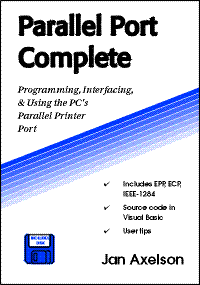Home > Parallel Port Complete > Table of Contents
 Parallel
Port Complete
Parallel
Port Complete
Table of Contents
1 Essentials
- Defining the Port: Port Types • System Resources • Addressing • Interrupts • DMA Channels • Finding Existing Ports
- Configuring: Port Options • Drivers • Adding a Port
- Port Hardware: Connectors • The Circuits Inside • Cables
- Multiple Uses for One Port: Security Keys
- Alternatives to the Parallel Port: Serial Interfaces • Other Parallel Interfaces • Custom I/O Cards • PC Cards
2 Accessing Ports
- The Signals: Centronics Roots • Naming Conventions • The Data Register • The Status Register • The Control Register • Bidirectional Ports
- Addressing: Finding Ports
- Direct Port I/O: Programming in Basic • Other Programming Languages
- Other Ways to Access Ports: LPT Access in Visual Basic • Windows API Calls • DOS and BIOS Interrupts
3 Programming Issues
- Options for Device Drivers: Simple Application Routines • DOS Drivers • Windows Drivers • Custom Controls
- Speed: Hardware Limits • Software Limits
4 Programming Tools
- Routines for Port Access: Data Port Access • Status Port Access • Control Port Access • Bit Operations
- A Form Template: Saving Initialization Data • Finding, Selecting, and Testing Ports
5 Experiments
- Viewing and Controlling the Bits: Circuits for Testing • Output Types • Component Substitutions
- Cables & Connectors for Experimenting
- Making an Older Port Bidirectional: Cautions • The Circuits • The Changes
6 Interfacing
- Port Variations: Drivers and Receivers • Level 1 Devices • Level 2 devices
- Interfacing Guidelines: General Design • Port Design
- Cable Choices: Connectors • Cable Types • Ground Returns • 36-wire Cables • Reducing Interference • Line Terminations • Transmitting over Long Distances
- Port-powered Circuits: When to Use Port Power • Abilities and Limits • Examples
7 Output Applications
- Output Expansion
- Switching Power to a Load: Choosing a Switch • Logic Outputs • Bipolar Transistors • MOSFETs • High-side Switches, Solid-state Relays • Electromagnetic Relays • Controlling the Bits • X-10 Switches
- Signal Switches: Simple CMOS Switch • Controlling a Switch Matrix
- Displays
8 Input Applications
- Reading a Byte: Latching the Status Inputs • Latched Input Using Status and Control Bits • 5 Bytes of Input • Using the Data Port for Input
- Reading Analog Signals: Sensor Basics • Simple On/Off Measurements • Level Detecting • Reading an Analog-to-digital Converter • Sensor Interfaces • Signal Conditioning • Minimizing Noise • Using a Sample and Hold
9 Synchronous Serial Links
- About Serial Interfaces
- A Digital Thermometer: Using the DS1620 • The Interface • An Application • Other Serial Chips
10 Real-time Control
- Periodic Triggers: Simple Timer Control • Time-of-day Triggers • Loop Timers
- Triggering on External Signals: Polling • Hardware Interrupts • Multiple Interrupt Sources • Port Variations
11 Modes for Data Transfer
- The IEEE 1284 Standard: Definitions • Communication modes
- Detecting Port Types: Using the New Modes • Port Detecting in Software • Disabling the Advanced Modes
- Negotiating a Mode: Protocol
- Controller Chips: Host Chips • Peripheral Chips • Peripheral Daisy Chains
- Programming Options
12 Compatibility and Nibble Modes
- Compatibility Mode: Handshaking • Variations
- Nibble Mode: Handshaking • Making a Byte from Two Nibbles
- A Compatibility & Nibble-mode Application: About the 82C55 PPI • Compatibility and Nibble-mode Interface
13 Byte Mode
- Handshaking
- Applications: Compatibility & Byte Mode • Compatibility, Nibble & Byte Mode with Negotiating
14 Enhanced Parallel Port: EPP
- Inside the EPP: Two Strobes • The Registers
- Handshaking: Four Types of Transfers • Switching Directions • Timing Considerations
- EPP Variations: Use of nWait • Clearing Timeouts • Direction Control
- An EPP Application: The Circuit • Programming
15 Extended Capabilities Port: ECP
- ECP Basics: The FIFO, Registers • Extended Control Register (ECR) • Internal Modes
- ECP Transfers: Forward transfers • Reverse Transfers • Timing Considerations • Interrupt Use • Using the FIFO
- Other ECP Modes: Fast Centronics • Test Mode • Configuration Mode
- An ECP Application
16 PC-to-PC Communications
- A PC-to-PC Cable
- Dos and Windows Tools: MS-DOS's Interlnk • Direct Cable Connection
- A PC-to-PC Application
Appendices
- Resources
- Microcontroller Circuit
- Number Systems
